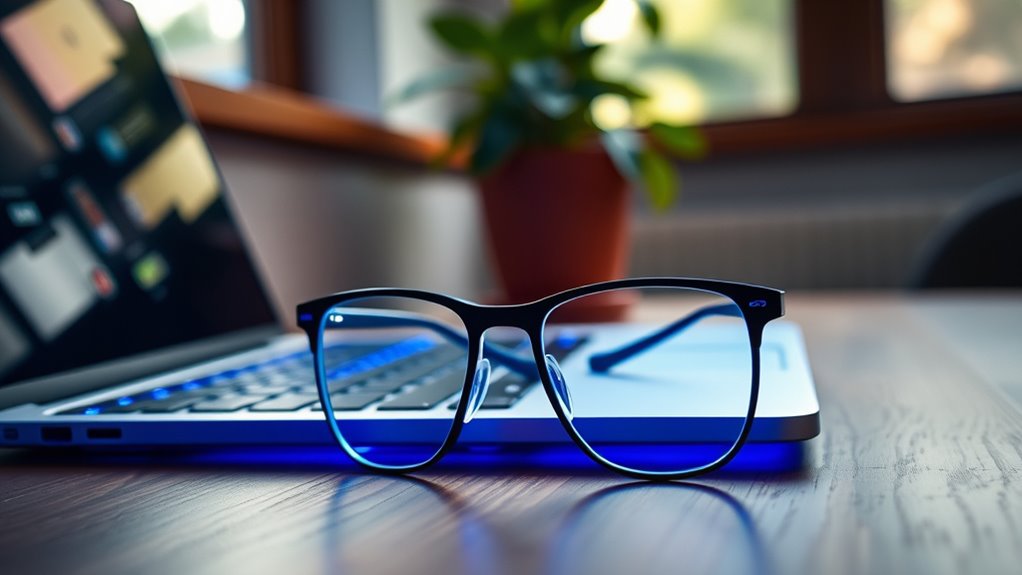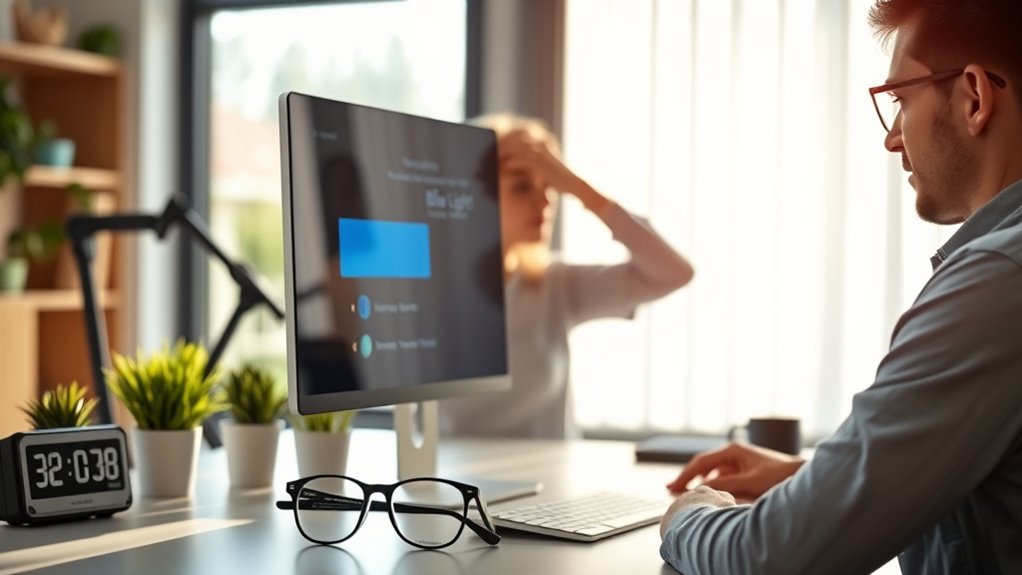To effectively reduce digital eye strain, optometrists recommend simple but proven strategies like adjusting your screen brightness to match your environment and using blue light filters or “night mode” during long screen sessions. Wearing blue light blocking glasses can also help ease discomfort. Maintaining proper indoor lighting and taking regular breaks are essential too. If you keep these tips in mind, you’ll improve your eye comfort and health—there’s more you can do to stay comfortable.
Key Takeaways
- Adjust screen brightness to match ambient lighting, reducing eye effort and discomfort.
- Use blue light filters or “night mode” during prolonged screen time to decrease eye fatigue.
- Wear blue light blocking glasses, especially in the evening, to minimize blue light exposure.
- Take regular breaks following the 20-20-20 rule: every 20 minutes, look at something 20 feet away for 20 seconds.
- Ensure proper indoor lighting and maintain good air quality to reduce overall eye strain and dryness.

If you spend hours staring at screens, digital eye strain can quickly become a frustrating problem. You might notice tired, dry, or itchy eyes, along with headaches and blurred vision. One of the main culprits is blue light exposure, which screens emit in considerable amounts. While blue light can’t be completely avoided, you can take practical steps to reduce its impact. Adjusting your screen brightness is one of the simplest, most effective measures you can implement. When your screen is too bright, it forces your eyes to work harder, increasing strain and discomfort. Conversely, if it’s too dim, your eyes strain to read or see clearly. Finding a comfortable brightness level that matches your environment is key. Many devices offer automatic brightness adjustment, which uses ambient light sensors to optimize your screen’s luminance. If yours doesn’t, manually tweaking the brightness to match your surroundings can make a big difference.
Adjust your screen brightness to match your environment for comfortable, strain-free eyes.
Screen brightness adjustment isn’t just about comfort; it’s about protecting your eye health. When your screen brightness is set improperly, your eyes have to compensate, leading to increased fatigue. Optometrists recommend setting your screen to roughly the same brightness as your environment. For example, if you’re in a dimly lit room, lower the brightness; if you’re in a well-lit space, increase it to prevent unnecessary strain. Using the built-in settings or a blue light filter can help you achieve this balance. Many screens now come with “night mode” or “blue light reduction” features that adjust color temperature and reduce blue light emission, making viewing more comfortable during long sessions. Additionally, maintaining proper indoor air quality can help reduce overall discomfort and keep your eyes healthier, especially in environments with dry or stagnant air.
In addition to adjusting your screen brightness, you should also consider limiting blue light exposure overall. Wearing blue light blocking glasses, especially during evening hours, can help reduce strain and improve sleep quality. These glasses filter out a substantial portion of blue light, easing the burden on your eyes. Combining this with proper screen brightness adjustment creates a powerful barrier against digital eye strain. Remember, the goal is to make your screen’s luminance as natural and comfortable as possible, mimicking the ambient light in your environment. This way, your eyes won’t have to work overtime to focus or adjust, reducing fatigue and discomfort.
Ultimately, managing blue light exposure and adjusting your screen brightness are simple yet highly effective strategies. They’re backed by optometrists and proven to make your digital experience more comfortable while safeguarding your eye health. With a few tweaks to your device settings and some mindful habits, you can appreciably reduce the symptoms of digital eye strain.
Frequently Asked Questions
Can Digital Eye Strain Cause Permanent Vision Damage?
Digital eye strain usually doesn’t cause permanent vision damage, but ignoring it can lead to discomfort and issues over time. You might experience blurred vision or headaches, which can affect your daily life. To protect your eyes, focus on proper vision correction and create an ergonomic setup for your workspace. Regular eye exams help catch problems early, ensuring your eyes stay healthy and comfortable, even with prolonged screen use.
Are There Specific Exercises to Prevent Eye Strain?
Ever notice how blinking more and practicing eye relaxation can surprisingly reduce eye strain? You can prevent discomfort by doing simple exercises like the 20-20-20 rule: every 20 minutes, look at something 20 feet away for 20 seconds. Increase your blink frequency to keep eyes moist, and try eye relaxation techniques like gentle palming. These small habits make a big difference in maintaining eye comfort during screen time.
How Long Does It Take to See Improvements?
You might start noticing improvements in your eye comfort within a few days to a week of practicing recommended exercises and habits. The visual recovery process varies depending on the severity of your symptoms and your adherence to the routine. Typically, you’ll see a symptom timeline where discomfort decreases gradually. Keep consistent with your eye care, and patience will help you achieve better eye health and reduced strain over time.
Do Blue Light Glasses Really Help Reduce Eye Strain?
You might wonder if blue light glasses really help reduce eye strain. While blue light myths persist, these glasses can block digital eye strain triggers like screen glare and blue light exposure, easing discomfort. They won’t eliminate eye strain completely, but many users notice less fatigue and dryness. To get the best results, combine them with regular breaks and proper lighting, addressing eye strain triggers more effectively.
Is Digital Eye Strain More Common in Certain Age Groups?
You might notice digital eye strain more in certain age groups, especially as age-related factors come into play. Kids and teens, who rapidly adopt new technology, often experience symptoms due to prolonged screen time. Adults and seniors, with changing vision and reduced tear production, also face increased risk. Your technology habits and eye health influence how much you’re affected, making it important to adapt your routines based on your age and usage.
Conclusion
Now that you know these proven fixes, your eyes can breathe easier as you navigate your digital world. Picture your vision clearing like a dawn sunrise, free from the haze of strain. By taking simple steps, you’re not just protecting your eyes—you’re safeguarding your ability to see life’s vibrant details. So, every time you pause and adjust, you’re restoring clarity and color to your everyday moments. Your brighter, more comfortable future starts with these easy, effective habits.











